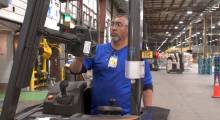Since the dawn of the new millennium, technology has evolved at a faster pace than ever before, directly influencing the tactics, objectives and, ultimately, productivity of thousands of industries. Materials handling is no exception.
A wide array of technologies are currently emerging (or emerged years ago and are now migrating) and penetrating materials handling, especially its maintenance and support aspects. Of these technologies, five in particular— augmented reality, automated locker systems, bar code scanners, RFID and voice technology—are reshaping maintenance practices in materials handling.
These technologies are not only impacting conventional materials handling support practices, but they are also enhancing the scope and capabilities of maintenance programs. Here’s a look at the current and potential uses for each technology in pursuit of optimal uptime, costs and productivity.
- Augmented Reality Augmented reality (AR) consists of superimposing contextual information over the user’s view, whether through a headset or through the screen of a mobile device. Imagine a pair of glasses whose wearer can see an illuminated path through a facility, a crosshairs on the target item, the manual for a piece of equipment, or even an overlaid animation of how to orient or install a part. For years before its application in the service of materials handling systems, AR has provided technicians a hands-free link between system information, such as conveyor speed and vibration, and instructions over audio and visual transmission. In the past, technicians had to carry scanners as they filled orders, but with see-through displays on headsets they can now scan bar codes or data matrix codes entirely hands-free. The displays’ indoor navigation also optimizes technicians’ routes as they locate problem areas, parts and the necessary tools. For example, as a result of the displays, technicians can more easily find the correct washer among a variety of bins, then locate whichever conveyor motor may need that particular washer, and collect a photographic record of each step. “The see-through displays will definitely have an impact on the way technicians work, as their errors will decline while their performances will be enhanced,” says Christian Zink, product manager for Knapp. AR is evolving at the same pace as most mobile devices and related software, the benefits of which offer significant productivity when integrated with the automated systems they support. Some companies are now offering customers mobile apps so they can perform system diagnostics with their smart phones, all of which is recorded and visible in real time. “Although augmented reality will play a secondary role in the field of materials handling in the future, but it will nonetheless increase overall equipment efficiency,” adds Andreas Werner, head of research and development for the Beumer Group. “More business models will contain augmented reality and applications, as companies will continue to focus on their response times and efficient transport.”
- Automated Locker Systems For more than 20 years, industries like aerospace and automotive have used automated locker systems to maintain the accountability of tools like handheld scanners and radios, thereby eliminating the potential costs of tool replacement and ensuring the right equipment is quickly accessible. In that time, the systems have consistently evolved. Not only are they easier to use and implement today, but they also offer technicians more robust functionality—as they are more configurable and modular—at a lower price than in the past. “The systems now automate checkout/ check-in processes to bolster productivity by eliminating the queue at the beginning and end of shifts, the time lost searching for misplaced assets or devices, and the overtime caused by the unavailability of those items,” says Kent Savage, CEO of Apex Supply Chain Technologies. “They also replace costly, inefficient manual processes, which eliminates human error and reduces related costs by up to 30%.” By providing technicians 24/7 accountability for the tools they need to maintain their parts and systems, automated locker systems also improve productivity, as the entire asset management process is streamlined and centralized. Managers can track, manage and control all items, so they know their condition, as well when they are checked out and returned. Locker systems are available in a variety of shapes and sizes to accommodate large, bulky items. Others provide power outlets so that battery-operated tools can be charged in the lockers. “The lockers will also manage the charge time and dispense the item with the longest charge,” says Glenn Pierce, director of implementation at SDI. “Furthermore, e-tools like laptops and iPads can also be charged while managing virus definitions and operating system updates.” Steve Pixley, founder and president of AutoCrib, believes the future usage of lockers, particularly to control the tools that maintain technicians’ parts and systems, will be driven by two trends. “An increasing number of companies are unwilling to pay for non-value added positions; the jobs that require employees to track the usage of MRO supplies will be eliminated and replaced with automated systems,” he explains. “More companies also want more visibility, as well as the ability to leverage big data so they can aggregate their spend and move tools and supplies to where they are needed.”
- Bar Code Scanners Before image-based scanners were available on the market, technicians could only scan 2D bar codes and direct part markings with costly devices. However, these same types of bar codes can now be read with devices that are more general purpose. For example, some technicians may choose to use handheld scanners, especially if they are in a storage area. These scanners can either be tethered to a computer or connected with Bluetooth. “These scanners will include a scan engine that is optimized for the task at hand,” says Mark Wheeler, director of supply chain solutions at Zebra Technologies. “Since scanning is typically close range in parts management, the scan engine will be chosen with that in mind.” Scan engines can also be integrated into handheld mobile computers, including tablets and all-touch devices. The engines are also based on laser or imaging technology; laser-based scanners will use lasers to scan across the bars of linear bar codes, while image-based scanners will actually capture and process images. Consequently, image-based scanners can read more bar codes, including 2D codes, than laser-based scanners, and provide omni-directional scanning so that laser lights do not have to be lined up across the bar codes. Some scanners can also be optimized for extremely small bar codes used in electronics manufacturing, while others are capable of reading damaged bar codes. “By choosing the right scanner for their specific needs, parts handlers will scan more accurately, easily and quickly than they have in the past,” Wheeler says. And, due to their low cost and near universal application, Wheeler believes bar code scanners will remain popular in the future. He adds, “We will also see growth in 2D imaging and the use of 2D symbologies since these codes can store a lot of data—like an item or a serial number— in a small space.”
- RFID Before RFID (radio frequency identification) technology was ever implemented in MRO processes, transactions were captured through an honor system that used scanners and clipboards. As RFID technology began to replace manual practices, technicians found that it had some limitations, as most tags were unable to withstand heat or the shock of forklift activity. Further, their read range was restricted when compared to the tags used today. Although the tags’ sustainability has improved considerably, RFID systems are currently either deployed in parallel with technologies like bar codes and vision systems, or they work in tandem with other technologies like automated lockers. “By deploying RFID in addition to bar codes, users can choose which data collection medium is best at a particular moment without compromising an ‘all or nothing’ technology approach,” says Tom O’Boyle, director of RFID for Barcoding, Inc. Considered to be the least expensive method to serialize and control a variety of tools and supplies through a locked or controlled panel, RFID technology has steadily increased in popularity over the years. The technology also helps technicians pinpoint the exact location in which an asset is deployed, as it is tracked and updated at the point of drop off or service. “Knowing an inventory’s location and count—with little or no need for users to manually enter data or stop and scan a bar code—is a powerful capability,” O’Boyle adds. “Through this level of instant visibility, organizations can obtain a clear direction of their assets, which allows them to make better business decisions without requests to validate the asset information.” By tracking individual assets, technicians can also virtually eliminate the problems often associated with inventory management, as they avoid stock-outs and incorrect inventory levels. In doing so, technicians can reduce their inventory consumption by approximately 20% to 40%, according to SDI’s Pierce. Although the current primary purpose of RFID technology is to locate and identify individual assets as easily and efficiently as possible, O’Boyle believes the technology will eventually be able to “track the health” of assets as well. “Logging and sending information, pertaining to humidity, temperature and other forms of health status, will allow users to materially manage the asset and predetermine service times,” O’Boyle says. “By knowing that a forklift needs servicing after a certain number of hours in motion, a suitable time for service can be determined before the unit breaks down.” “This prevents last minute, emergency maintenance that can slow down operations and impact a plant’s overall efficiency, accuracy and connectivity,” he adds.
- Voice technology Unlike paper-based order fulfillment, which often results in errors, voice technology enables users to deliver their work orders entirely hands free with a wireless headset. This is as important for the efficiency and productivity of technicians as it is for pickers. Once an item has been selected, warehouse team members confirm the selection by speaking in the headset microphone. The voice system then records the confirmation,” says Keith Phillips, president and CEO of Voxware. As a result of the hands-free technology, technicians no longer need to verify their orders in physical documents and manually enter information at a later time. Instead, they can focus on other tasks, leading to a potential additional hour of productive time per employee every month, according to Bruce Stubbs, director of supply chain marketing for Honeywell Sensing and Productivity Solutions. “The solution, which responds to voice feedback from individual workers, transforms materials handling personnel into ‘connected workers’ to boost their efficiency,” Stubbs explains. “Connected workers are more productive and less likely to make errors. They can better plan their work process and eliminate unnecessary travel time within the warehouse.” By implementing voice technology, Stubbs has found that pickers or technicians can increase their productivity by 35%, achieve 99.99% accuracy and cut errors by as much as 25%.

Companies mentioned in the article:
Apex Supply Chain Technologies
AutoCrib
Barcoding, Inc
Beumer Group
Honeywell Sensing and Productivity Solutions
Knapp
SDI
Voxware
Zebra Technologies








